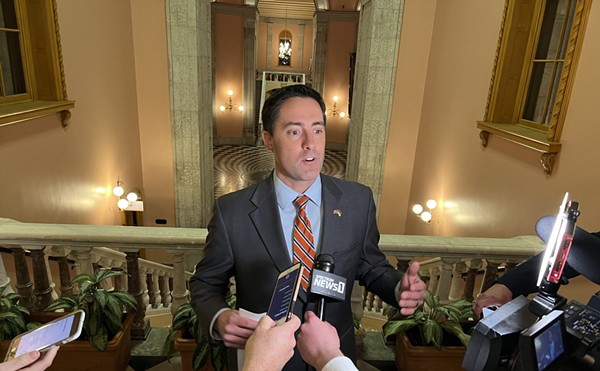The fire spread fast and flickered madly against the trees along Daniel Miller's property line. At 10:54 p.m. on Feb. 8, 2014, six Loudonville firefighters arrived by truck to find Miller's dog kennel completely ablaze. According to the fire department, the fire was "under control" by 12:10 a.m.
A record of the fire appears in a single-column Ashland Times-Gazette story on Feb. 15. "Officially, the fire is still under investigation," fire chief Tom Gallagher told the paper at the time. In the week since the fire, he and Capt. Todd McElwain had visited the property twice. Miller wasn't home, and so the investigation stalled. McElwain said he thought maybe 12 dogs had died in the fire. He didn't know how many might have run away.
Neighbor Lee Gaines was quoted by the paper as saying that far more than a dozen dogs had been held at the kennel. "That place has bothered me for years, especially the noise, dogs barking all night some nights," he told the paper. (Police records show that in 2008, Gaines also told police that "100-200" dogs lived on the property.) On the night of the fire, a 911 caller told the Ashland County Sheriff's Office that "over 60" dogs lived there.
It's unclear what happened on the night of Feb. 8, 2014, and it's unclear how many dogs perished in the fire. The investigation was never finished. What is clear to those who were paying attention back then is that by Feb. 22 the barn was rebuilt with quickly claimed insurance money, according to notes from neighbor Judy Roberts. Workers poured the new cement floor on "approximately" Feb. 27. The fire and its cause were wiped from history.
Roberts says she spoke with the fire chief on Feb. 20, telling him about the backhoe work on the property. "He told me we'll probably never know the source of [the] fire," she wrote in notes given to Scene. Another neighbor surmises that Miller left one or two —maybe as many as three — gas lanterns lit inside the kennel that night. According to an amalgam of notes and incomplete reports, Miller was not at home during the blaze.
The fire and its subsequent lack of any investigation remain troublesome developments for those who observe the dog breeding industry in Ohio. While a new law hit the books down in Columbus a few years back, advocates for animal protection aren't convinced it's doing much. What's happening at Miller's property is just one example.
The Commercial Dog Breeders Act went into effect in March 2013, garnering statewide fanfare and outcry. The law requires licensure of "high-volume" dog breeders — those whose dogs "produce at least nine litters of puppies in any given calendar year and [who sell] 60 or more adult dogs or puppies per calendar year." (The word "and" is key here. This is called "the 9/60 rule" in state parlance.)
What the state found is that 182 breeders fall into that distinction. Erica Hawkins, spokesperson for the Ohio Department of Agriculture (ODA) told Scene that, prior to enactment, the department estimated anywhere from 300 to 1,000 breeders might fall into that distinction.
With the law's implementation, those 182 are now subject to annual inspection by the Ohio Department of Agriculture, and they are required to pay $150 to $750 in licensure fees. Mandatory liability insurance clocks in at between $5,000 and $50,000. (Violators are assessed a $100 fine.) The state also reports that there are 252 licensed dog retailers in the state — and many high volume breeders double as retailers.
"When you have limits in the statute — and that could be about this program or any slew of regulations that we oversee — when there's a threshold limit that you have to cross in order to fall into the regulations, I think there are always going to be people who would rather sit right under that line," Hawkins says. It's a concern for the department, but for now there's no way of knowing how many breeders are working in Ohio outside of the prescribed 9/60 structure.
According to ODA records, Miller's property falls outside both categories. As such, there's no obligation for the ODA inspectors to look into his kennel.
Soon after the fire, Ashland County dog warden Thomas Kosht visited Miller's property. He found "dogs in kennels suspended from the rafters in a building which had one wall ... and was open on three sides," according to a letter filed March 19, 2014, with the county prosecutor. "The dogs in the kennels had no bedding or anything to lie on except the wire floor of the kennel."
According to records, Kosht told Miller to take care of the kennel's exposure to the elements. (Some of the dogs were entirely exposed to late-winter wind, and piles of feces were mounting outside their cages.) "Before leaving, [the ODA inspector and I] let Daniel Miller know again what needed to be done on a temporary basis to protect the dogs from the weather and he agreed to tend to the problem as the temperature for the evening was going to get to near zero degrees." Kosht wrote.
Really, though, for breeders like Miller who fall beneath the 9/60 rule structure, there's little that the state or local authorities can do. There's no "teeth" to the laws on hand, one might say. No records are provided to government agencies for those breeders, keeping them far from the eyes of regulators. It takes a complaint — or a fire — to bring an inspector into the fold.
That all becomes a problem, because there's a great deal of gray area in which breeders can operate. Hawkins says that breeders who aren't covered by the 9/60 rule fall outside of the state's oversight up to the point that their behavior intersects with Ohio's "animal cruelty" statutes.
Prior to 2013, there was no state oversight for dog breeders. Nowadays, there's at least the appearance of it. Advocates for animal safety now find themselves at once applauding the fact that there's some state law on the books while decrying its limited scope.
Board member Linda Stickney expressed some concern in the July 2015 meeting about the enforcement of the laws and whether those laws will do much to address dogs being left out in the elements.
According to neighbors, ODA inspector Kurt Pfeiffer found frozen dog carcasses on Miller's property two weeks prior to the fire. "Nothing was done about it," Roberts says. According to notes, Pfeiffer's boss, Richard Counter, reportedly later told neighbors he did not know about the frozen dogs. (Counter referred Scene over the phone to Hawkins.)
That wasn't the only time that dead dogs had been discovered on Miller's property.
It was with some sense of trepidation that I arrived in Loudonville in July. More than a year had passed since the fire, but that night had not been forgotten. A neighbor from down the road took me onto a friend's property that abutted Miller's land. We walked along the treeline that separated the two pieces of property, picking bramble berries and making idle conversation about the weather to avoid wandering eyes and ears.
As Miller's dogs barked frantically, raising hell from within their kennels, we moved down the property line. I couldn't help but feel profound dread. Enormous flies flicked around our heads. As we got closer to the site, the stench of death clung to the air.
A pile of dog carcasses was stashed among the trees. Skulls lay half-buried in dirt. A small spinal cord rested at the base of a sapling. Some of the carcasses still had fur. Visibly, some of the bones could presumably be traced back to deaths that occurred during the 2014 fire; others had clearly died more recently.
Jackie Hillyer, who brought me to the mound of dogs, says she's profoundly troubled by the lack of care for these animals and the ensuing lack of consequences. "I want it to be known what goes on," she says, adding that this case is but one in a sea of breeders across Ohio.
Another neighbor told Hillyer that the bodies had been stashed in the woods "for about four or five years now."
"If they would have been out there to check, they would have found these dead dogs years ago," Hillyer says. "They encourage being inhumane to animals. It's all in the guise of, 'How much money are we going to make from these people?'"
Even using the most conservative estimates, the new structure of Ohio's dog breeding industry spits out tens of thousands of dollars for the state each year. For the untold number of breeders left outside state regulations, they don't even have to pay for the privilege.











